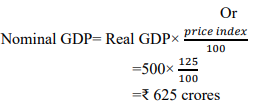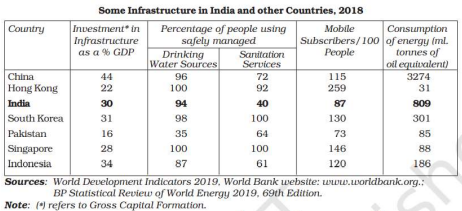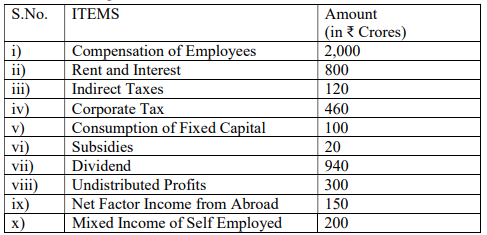1. Distinguish between Final Goods and Intermediate Goods.
Or
Distinguish between positive externalities and negative externalities.
Answer.
Final goods refer to those goods which are used either for final consumption or for investment purposes. Whereas Intermediate goods refer to those goods which are used either for resale or for further production purposes.
Or
Positive externalities refer to benefits caused by one entity to another, without being paid for it. Whereas Negative externalities refer to the harms caused by one entity to another without being penalized for it.
2. Calculate equilibrium level of income for a hypothetical economy, for which it is given that:
a) Autonomous s Investments = ₹ 500 crores, and
b) Consumption function, C = 100 + 0.80Y
Or
Calculate Change in Income (ΔY) for a hypothetical economy.Given that:
a) Marginal Propensity to Consume (MPC) = 0.8, and
b) Change in Investment (ΔI) = ₹1,000 crores
Answer.
Given Consumption function is,
C=100+0.8 Y Autonomous investments=500 crores We know, at equilibrium level
Y=C+I
Y=100+0.8 Y+500
Y-0.8Y=600
0.2 Y =600
Y= ₹ 3,000 crores
Or
Given Δ I = ₹1,000 crores
MPC = 0.8
As we know,

3 ‘As the income increases, people tend to save more’. Justify the given statement.
Answer.
At a lower level of income, a consumer spends a larger proportion of his/her income on consumption expenditure (basic survival requirements). As the income increases, owing to the psychological behavior of a consumer (rational), people tend to consume less and
save more for future uncertainty.
4 State and discuss any two indicators that help in measuring the health status of a country.
Or
Compare and analyze the ‘Women Worker Population Ratio’’ in Rural and Urban areas based on following information:

Answer.
Two indicators that help to measure the health status of a country are:
a) Infant Mortality Rate – Infant Mortality Rate (or IMR) indicates the number of children that survive first year of their life.
b) Literacy Rate – Literacy rate measures the proportion of literate population in the age
1
1
group of seven years or above.
Or
The data in the given table reveals that:
a) Women constitute 16.5% of the total worker population in the economy.
b) The number of women workers in rural areas (17.5%) are relatively higher than the
women workers in urban areas (14.2%). Due to the abject poverty in rural areas, rural women are compelled to work more than their urban counterparts.
5. ‘Investment in infrastructure contributes to the economic development of a country.’ Justify the given statement with a valid argument.
Answer.
The given statement is true; infrastructural development in an economy increases productivity, induces higher investment, facilitates employment, and generates more income. With the rise in income the quality of life of the people improves. Thus, conclusively we may say that infrastructure contributes to the economic development of a country.
6 Giving valid reasons explain which of the following will not be included in estimation of National Income of India?
a) Purchase of shares of X. Ltd. by an investor in the National Stock Exchange.
b) Salaries paid by the French housekeeping department.
c) Compensation paid by the Government of India to the victims of floods.
Or
Estimate the value of Nominal Gross Domestic Product for a hypothetical economy, the value of Real Gross Domestic Product and Price Index are given as respectively.
Answer.
Following will not be included in estimation of National Income of India:
a. As such transactions are mere paper claims and do not lead to any value addition.
c. Compensation paid by the Government of India is mere transfer payment and does not lead to any flow of goods and services in an economy.
Or

7 Study the following information and compare the Economies of India and Singapore on the grounds of ‘Investment in infrastructure as a percentage of GDP’

Answer.
‘Investment in infrastructure as a percentage of GDP’ is that proportion of Gross Domestic Product which is invested for the development of infrastructural facilities in a country. According to the given data it is evident that India is contributing 30% of its total GDP on infrastructural progress, which is just a notch above the corresponding figure of 28%
for Singapore. Considering the vast geography of India this is a relatively lower proportion in this direction. If India wants to grow at a faster rate, she must concentrate on higher judicious investment on development of infrastructure.
8 Outline and discuss any two economic advantages of China Pakistan Economic Corridor (CPEC) accruing to the economy of Pakistan.
Answer.
Economic advantages of China Pakistan Economic Corridor (CPEC) to the economy of Pakistan are:
i. China provided financial and technical expertise to help Pakistan build its road infrastructure, supporting employment and income in the economy
ii. CPCE has led to a massive increase in power generation capacity of Pakistan. It has brought an end to supply-side constraints in the nation, which had made blackouts a regular phenomenon across the country.
9 Analyse the implication of bilateral ‘debt-trap’ situation of Pakistan vis-à-vis the Chinese Economy.
Answer.
China has become famous for its ‘Debt Trap Diplomacy’ in recent times. Under this 3 China provides financial and technical expertise/assistance to help various nations to bring them under its direct or indirect influence. The first and the foremost implication of the diplomacy is that Beijing has now become Islamabad’s largest creditor. According to documents released by Pakistan’s finance ministry, its total public external debt stood at $44.35 billion in June 2013, just 9.3
percent of which was owed to China. By April 2021, this external debt had ballooned to $90.12 billion, with Pakistan owing 27.4 percent —$24.7 billion — of its total external debt to China, according to the IMF.
10 Explain how ‘Non-Monetary Exchanges’ impact the use of Gross Domestic Product as an index of economic welfare.
Answer.
Non-monetary exchange transactions are not included in the estimation of Gross Domestic Product on account of practical difficulties like non-availability of reliable data. Although these activities enhance public welfare which may lead to underestimation of GDP. For example: kitchen gardening, services of homemaker etc.
11 ‘Monetary measures offer a valid solution to the problem of Inflationary gap in an economy’. State and discuss any two monetary measures to justify the given statement.
Answer.
Two measures which may be used to solve the problem of inflation are:
a) An increase in Cash Reserve Ratio (CRR) may reduce the credit creation capacity of the commercial banks in the economy. This may lead to a fall in the borrowings from banks causing a fall in Aggregate Demand in the economy, and helps to correct the inflationary gap in the economy.
b) Sale of Government Securities in the open market by the Central Bank will adversely affect the ability of the Commercial Banks to create credit in the economy. As a result Aggregate Demand in the economy may fall and correct the inflationary gap in the economy.
12 a) From the following data calculate the value of Domestic Income:

b) Distinguish between ‘Value of Output’ and ‘Value Added’.
Or
a) Given the following data, find Net Value Added at Factor Cost by Sambhav (a farmer) producing Wheat:

b) State any two components of ‘Net Factor Income from Abroad’.
Answer.
a) Domestic Income (NDP@fc) =(i)+(ii)+(iv)+(vii)+(viii)+(x)
=₹2000+₹800+₹460+₹940+₹300+₹200
=₹4,700 crore
b) Value of output is the estimated money value of all the goods and services, inclusive of change in stock and production for self-consumption. Whereas, Value added is the excess of value of output over the value of intermediate consumption.
Or




